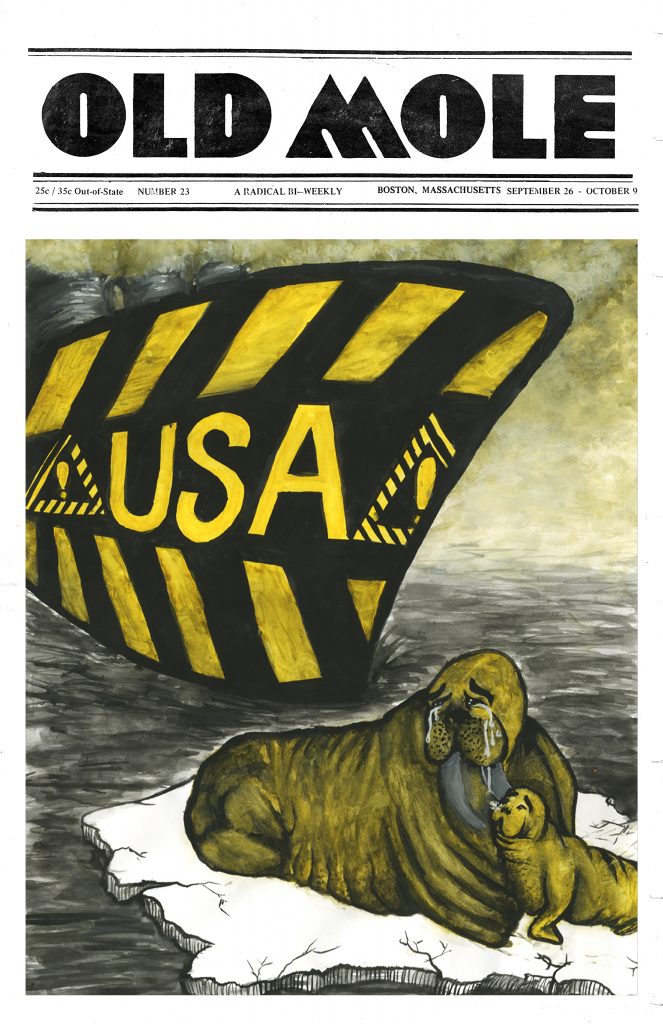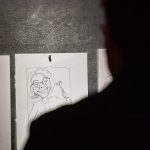When New York City politician William “Boss” Tweed was under attack by newspapers in the 1870s, he was most upset by the work of Thomas Nast, who is considered the “Father of the American Cartoon.”
“I don’t care a straw for your newspaper articles,” the head of the corrupt Tammany Hall political machine reportedly said of Nast’s employer, Harper’s Weekly, before eventually being arrested and convicted of fraud. “My constituents don’t know how to read, but they can’t help seeing them damned pictures.”
The challenge of creating an impactful image in one panel is not for the faint-hearted, as students in the “Topics in Illustration” class discovered earlier this semester when they received that assignment from Alison Paul, assistant professor of illustration/animation, and later, a critique of their initial sketches from Paul and cartoonist Dwayne Booth, known professionally as Mr. Fish.
Booth served as guest curator for “What’s the Alternative?: The Art and Outrage of the 1960s Underground Press,” a recent exhibition at the William Benton Museum of Art.
The assignment for the 15 students – primarily seniors concentrating on illustration in the Art & Art History Department – was to develop three single-panel concepts from one of three categories: health care, student loan debt, or climate change. The finished drawing was required to be in black and white, but also using one color, similar to the two-color printing format used in the Benton exhibition.
“The other restriction was no Donald Trump imagery, simply because it seems overdone and a cheap way of getting a response out of your viewers, either positive or negative,” Paul says. “One of the reasons we picked those subjects is because they are kind of age-old subjects. They’re also contemporary, but people can have had opinions on them for years.”
As the students posted their initial sketches in an art studio classroom on the second floor of the Bishop Center, several focused on student debt, a topic close to most in the room. Images included a snow-covered “Welcome to Florida” sign behind two campers warming before a fire, a funeral service for Sleeping Beauty, and Education Secretary Betsy DeVos about to smash a piggy bank with a carpenter’s hammer.

Helena Sirken ’19 (SFA), a digital media design major with a concentration in animation and motion graphics, addressed climate change in her sketch of a walrus floating on a small iceberg cowering, with its fins covering its eyes as a ship with the name U.S. Government approached. Booth described the concept as “a smart idea,” and suggested a more exaggerated rendering with the bow of the ship looming closer and making the walrus more vulnerable, which is what she did in her finished submission.
“Walruses don’t do this, express sorrow,” he says. “If you’re going to have your animal do something, it should be something that it wouldn’t do – maybe it’s reading a book, or sketching something in the snow on the iceberg. Then you can create drama in the situation.”
Senior Anthony Simpson ’19 (SFA), an art and art history major with a concentration in illustration, used imagery of a loan shark for his sketch focused on student loan debt, which Booth noted had strong ideas but required too much reading with text for the audience to understand quickly. His finished cartoon was a play on the “Jaws” poster.
“I thought Mr. Fish gave me some very reliable feedback that I could use to push my ideas, because the execution wasn’t there,” Simpson says. “The biggest advice that he gave me was that I should trust the audience more. I’m just going to leave it up to them, and hope my visual communication is strong enough so they can understand it.”
[To read cartoons,] you have to learn how to appreciate not only how it’s a nuanced language, but also how, if we want to use the metaphor of a megaphone, it’s louder than print. — Mr. Fish
Booth’s work often uses images and profanity aimed at promoting conversation on topical political issues in a variety of print and online news organizations, including Harper’s, The Nation, Los Angeles Times, and Village Voice, which recently ceased publication. While moving through his critiques of the student’s work, he sometimes indicated how he might render the idea, as in the image of DeVos with the piggy bank. He said he might have chosen to replace the hammer with a shotgun. As a result, student Many Trinh ’19 (SFA), an art and art history major with a concentration in illustration, reworked her idea to have DeVos using a sledgehammer.
“People don’t exactly know how to read cartoons anymore,” Booth said about the challenge of communicating often complex ideas with a single image. “I keep referring to it as a language, and you have to learn how to appreciate not only how it’s a nuanced language, but also how, if we want to use the metaphor of a megaphone, it’s louder than print. We’ve just gotten to a place where anything that has volume to it subject-wise is going to be misinterpreted as shrill, and is going to be told to quiet down. The difference is that the artists have remained, broadly speaking, very much the same. It’s the audience that’s being conditioned to be much more conservative in how willing they are to engage with material that is louder than they’re used to.”
The critique of conceptual ideas and sketches is a staple in art classes, allowing students to experience and understand the process they will go through when they work with art directors and other clients upon graduation.
“We do really try to run the course in a professional manner,” says Paul. “We try give them as many real life assignments as possible, and create an environment that is like the profession so that they can get a taste of what that’s like. They should be coming in with what they might give an art director in less than a year.”
Sirken says having the opportunity to receive an evaluation of her work from a respected professional such as Booth is a valuable experience.
“It’s always nice to get an outside perspective, especially when your teacher kind of knows what you’ve been working on the whole time,” she says. “Someone very prominent in the field like Mr. Fish can come in and give you comments and tell you what he thinks of your work, what he sees, and how he thinks you can improve it. I think that’s the best kind of critique you can get.”









